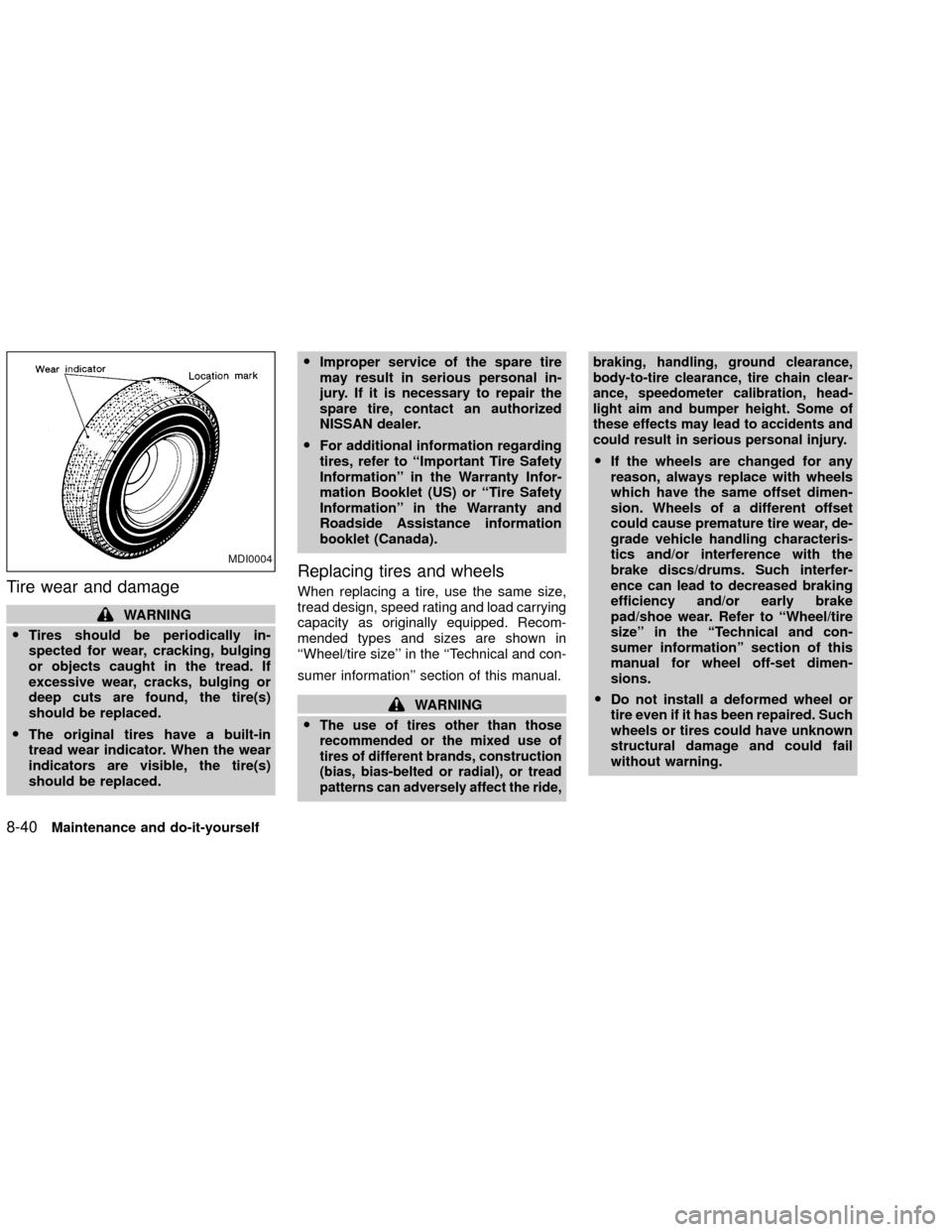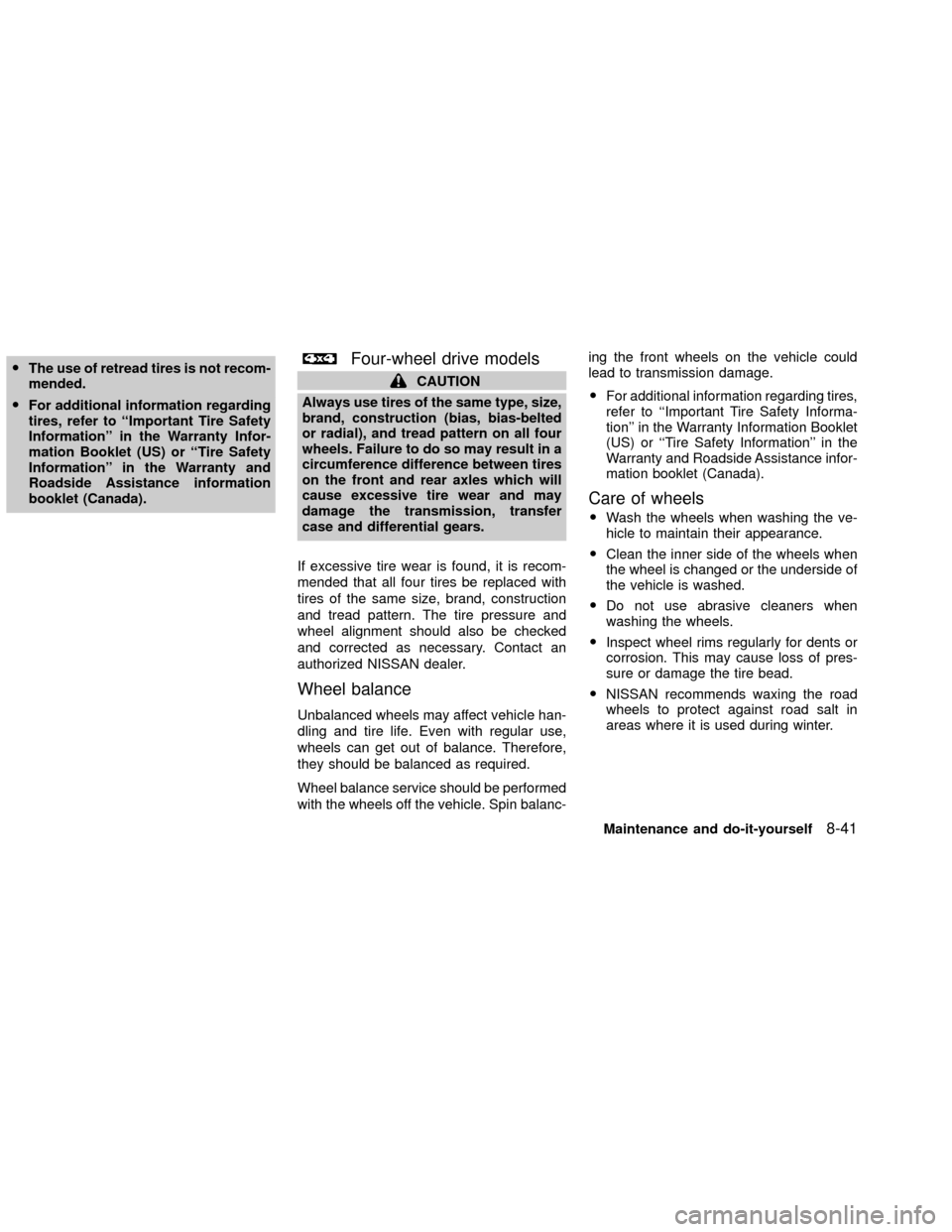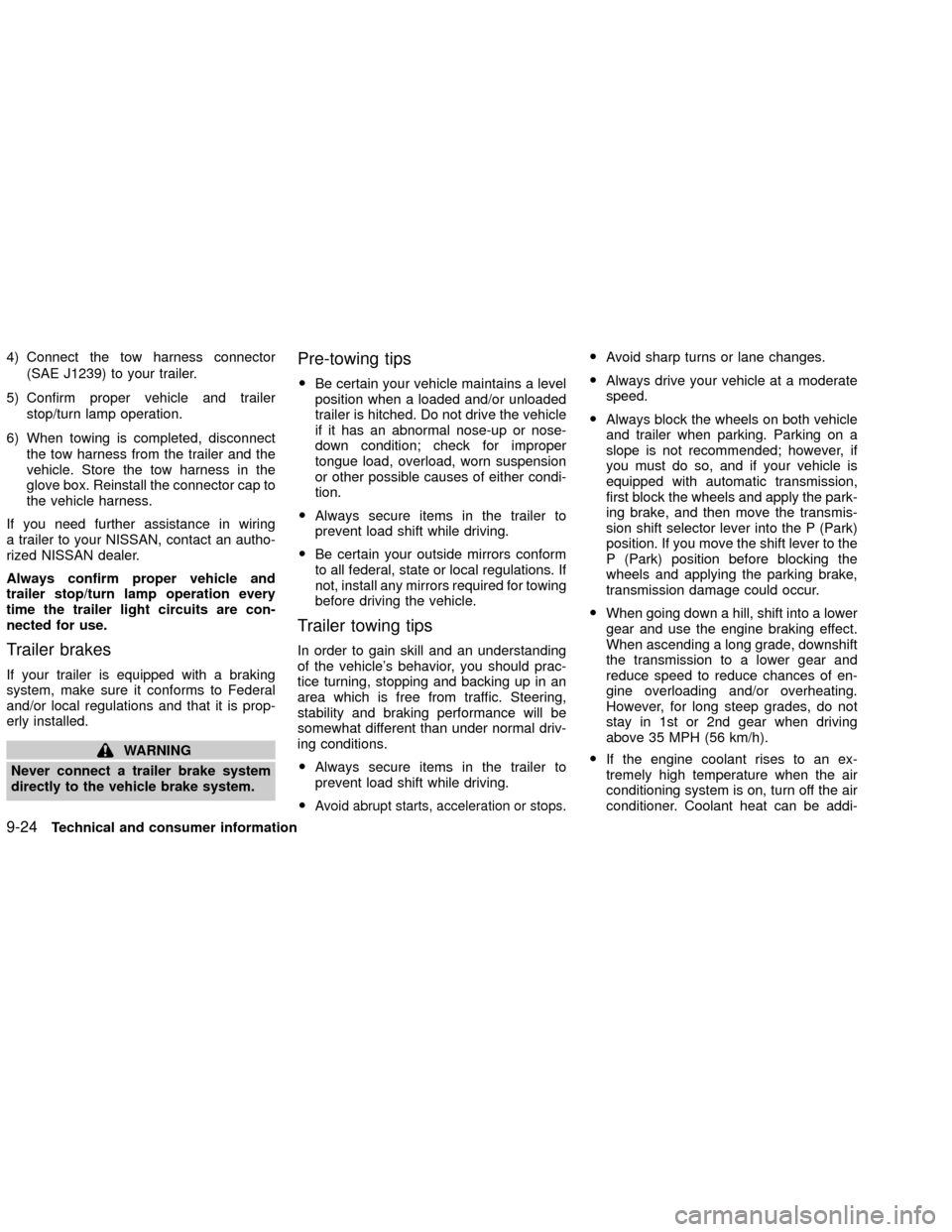2002 NISSAN XTERRA change wheel
[x] Cancel search: change wheelPage 222 of 263

erwise, your vehicle may be damaged
and/or vehicle handling and performance
may be adversely affected.
Never install tire chains on a TEMPORARY
USE ONLY spare tire.
Tire chains must be installed only on the
rear wheels and not on the front wheels.
Do not use tire chains on dry roads. Driving
with chains in such conditions can cause
damage to the various mechanisms of the
vehicle due to some overstress. When driv-
ing on clear paved roads, be sure to change
to 2WD.
CHANGING WHEELS AND TIRES
Tire rotation
NISSAN recommends rotating the tires ev-
ery 7,500 miles (12,000 km).
See ``Flat tire'' in the ``In case of emergency''
section for tire replacing procedures.
Wheel nut tightening torque:
98 ft-lb (133 Nzm)
WARNING
OAfter rotating the tires, check and
adjust the tire pressure.
ORetighten the wheel nuts when the
vehicle has been driven for 600 miles
(1,000 km) (also in cases of a flat tire,
etc.).
ODo not include the spare tire in the
tire rotation.
OFor additional information regarding
tires, refer to ``Important Tire Safety
Information'' in the Warranty Infor-
mation Booklet (US) or ``Tire Safety
Information'' in the Warranty and
Roadside Assistance information
booklet (Canada).
ADI1115
Maintenance and do-it-yourself8-39
ZX
Page 223 of 263

Tire wear and damage
WARNING
OTires should be periodically in-
spected for wear, cracking, bulging
or objects caught in the tread. If
excessive wear, cracks, bulging or
deep cuts are found, the tire(s)
should be replaced.
OThe original tires have a built-in
tread wear indicator. When the wear
indicators are visible, the tire(s)
should be replaced.OImproper service of the spare tire
may result in serious personal in-
jury. If it is necessary to repair the
spare tire, contact an authorized
NISSAN dealer.
OFor additional information regarding
tires, refer to ``Important Tire Safety
Information'' in the Warranty Infor-
mation Booklet (US) or ``Tire Safety
Information'' in the Warranty and
Roadside Assistance information
booklet (Canada).
Replacing tires and wheels
When replacing a tire, use the same size,
tread design, speed rating and load carrying
capacity as originally equipped. Recom-
mended types and sizes are shown in
``Wheel/tire size'' in the ``Technical and con-
sumer information'' section of this manual.
WARNING
O
The use of tires other than those
recommended or the mixed use of
tires of different brands, construction
(bias, bias-belted or radial), or tread
patterns can adversely affect the ride,braking, handling, ground clearance,
body-to-tire clearance, tire chain clear-
ance, speedometer calibration, head-
light aim and bumper height. Some of
these effects may lead to accidents and
could result in serious personal injury.
OIf the wheels are changed for any
reason, always replace with wheels
which have the same offset dimen-
sion. Wheels of a different offset
could cause premature tire wear, de-
grade vehicle handling characteris-
tics and/or interference with the
brake discs/drums. Such interfer-
ence can lead to decreased braking
efficiency and/or early brake
pad/shoe wear. Refer to ªWheel/tire
sizeº in the ªTechnical and con-
sumer informationº section of this
manual for wheel off-set dimen-
sions.
ODo not install a deformed wheel or
tire even if it has been repaired. Such
wheels or tires could have unknown
structural damage and could fail
without warning.
MDI0004
8-40Maintenance and do-it-yourself
ZX
Page 224 of 263

OThe use of retread tires is not recom-
mended.
OFor additional information regarding
tires, refer to ``Important Tire Safety
Information'' in the Warranty Infor-
mation Booklet (US) or ``Tire Safety
Information'' in the Warranty and
Roadside Assistance information
booklet (Canada).Four-wheel drive models
CAUTION
Always use tires of the same type, size,
brand, construction (bias, bias-belted
or radial), and tread pattern on all four
wheels. Failure to do so may result in a
circumference difference between tires
on the front and rear axles which will
cause excessive tire wear and may
damage the transmission, transfer
case and differential gears.
If excessive tire wear is found, it is recom-
mended that all four tires be replaced with
tires of the same size, brand, construction
and tread pattern. The tire pressure and
wheel alignment should also be checked
and corrected as necessary. Contact an
authorized NISSAN dealer.
Wheel balance
Unbalanced wheels may affect vehicle han-
dling and tire life. Even with regular use,
wheels can get out of balance. Therefore,
they should be balanced as required.
Wheel balance service should be performed
with the wheels off the vehicle. Spin balanc-ing the front wheels on the vehicle could
lead to transmission damage.
OFor additional information regarding tires,
refer to ``Important Tire Safety Informa-
tion'' in the Warranty Information Booklet
(US) or ``Tire Safety Information'' in the
Warranty and Roadside Assistance infor-
mation booklet (Canada).
Care of wheels
OWash the wheels when washing the ve-
hicle to maintain their appearance.
OClean the inner side of the wheels when
the wheel is changed or the underside of
the vehicle is washed.
ODo not use abrasive cleaners when
washing the wheels.
OInspect wheel rims regularly for dents or
corrosion. This may cause loss of pres-
sure or damage the tire bead.
ONISSAN recommends waxing the road
wheels to protect against road salt in
areas where it is used during winter.
Maintenance and do-it-yourself
8-41
ZX
Page 249 of 263

4) Connect the tow harness connector
(SAE J1239) to your trailer.
5) Confirm proper vehicle and trailer
stop/turn lamp operation.
6) When towing is completed, disconnect
the tow harness from the trailer and the
vehicle. Store the tow harness in the
glove box. Reinstall the connector cap to
the vehicle harness.
If you need further assistance in wiring
a trailer to your NISSAN, contact an autho-
rized NISSAN dealer.
Always confirm proper vehicle and
trailer stop/turn lamp operation every
time the trailer light circuits are con-
nected for use.
Trailer brakes
If your trailer is equipped with a braking
system, make sure it conforms to Federal
and/or local regulations and that it is prop-
erly installed.
WARNING
Never connect a trailer brake system
directly to the vehicle brake system.
Pre-towing tips
OBe certain your vehicle maintains a level
position when a loaded and/or unloaded
trailer is hitched. Do not drive the vehicle
if it has an abnormal nose-up or nose-
down condition; check for improper
tongue load, overload, worn suspension
or other possible causes of either condi-
tion.
OAlways secure items in the trailer to
prevent load shift while driving.
OBe certain your outside mirrors conform
to all federal, state or local regulations. If
not, install any mirrors required for towing
before driving the vehicle.
Trailer towing tips
In order to gain skill and an understanding
of the vehicle's behavior, you should prac-
tice turning, stopping and backing up in an
area which is free from traffic. Steering,
stability and braking performance will be
somewhat different than under normal driv-
ing conditions.
OAlways secure items in the trailer to
prevent load shift while driving.
O
Avoid abrupt starts, acceleration or stops.
OAvoid sharp turns or lane changes.
OAlways drive your vehicle at a moderate
speed.
OAlways block the wheels on both vehicle
and trailer when parking. Parking on a
slope is not recommended; however, if
you must do so, and if your vehicle is
equipped with automatic transmission,
first block the wheels and apply the park-
ing brake, and then move the transmis-
sion shift selector lever into the P (Park)
position. If you move the shift lever to the
P (Park) position before blocking the
wheels and applying the parking brake,
transmission damage could occur.
OWhen going down a hill, shift into a lower
gear and use the engine braking effect.
When ascending a long grade, downshift
the transmission to a lower gear and
reduce speed to reduce chances of en-
gine overloading and/or overheating.
However, for long steep grades, do not
stay in 1st or 2nd gear when driving
above 35 MPH (56 km/h).
OIf the engine coolant rises to an ex-
tremely high temperature when the air
conditioning system is on, turn off the air
conditioner. Coolant heat can be addi-
9-24Technical and consumer information
ZX
Page 250 of 263

tionally vented by opening the windows,
switching the fan control to high and
setting the temperature control to the
HOT position.
OTrailer towing requires more fuel than
normal circumstances.
OAvoid towing a trailer for your vehicle's
first 500 miles (805 km).
OHave your vehicle serviced more often
than at intervals specified in the recom-
mended Maintenance Schedule.
OWhen making a turn, your trailer wheels
will be closer to the inside of the turn than
your vehicle wheels. To compensate for
this, make a larger than normal turning
radius during the turn.
OCrosswinds and rough roads adversely
affect vehicle/trailer handling, possibly
causing vehicle sway. When being
passed by larger vehicles, be prepared
for possible changes in crosswinds that
could affect vehicle handling. If swaying
does occur, firmly grip the steering
wheel, steer straight ahead, and immedi-
ately (but gradually) reduce vehicle
speed. This combination helps to stabi-
lize the vehicle. Never increase speed.OBe careful when passing other vehicles.
Passing while towing a trailer requires
considerably more distance than normal
passing. Remember the length of the
trailer must also pass the other vehicle
before you can safely change lanes.
OTo maintain engine braking efficiency
and electrical charging performance, do
not use fifth gear (manual transmission)
or overdrive (automatic transmission).
OAvoid holding the brake pedal down too
long or too frequently. This could cause
the brakes to overheat, resulting in re-
duced braking efficiency.
When towing a trailer, change oil in the
transmission more frequently. For addi-
tional information see the ``Maintenance
and do-it-yourself'' section earlier in this
manual.DOT (Department of Transportation) Quality
Grades: All passenger car tires must con-
form to Federal Safety Requirements in
addition to these grades.
Quality grades can be found where appli-
cable on the tire sidewall between tread
shoulder and maximum section width. For
example:
Treadwear 200 Traction AA Temperature A
Treadwear
Treadwear grade is a comparative rating
based on tire wear rate when tested under
controlled conditions on specified govern-
ment test courses. For example, a tire
graded 150 would wear one and a half
(1-1/2) times as well on the government
course as a tire graded 100. However, rela-
tive tire performance depends on actual
driving conditions, and may vary signifi-
cantly due to variations in driving habits,
service practices and differences in road
characteristics and climate.
Traction AA, A, B and C
The traction grades from highest to lowest
are AA, A, B, and C. Those grades repre-
sent the tire's ability to stop on wet pave-
UNIFORM TIRE QUALITY
GRADING
Technical and consumer information9-25
ZX
Page 256 of 263

10 Index
A
Air bag (See supplemental restraint
system)....................................................... 1-11
Air bag warning light .................................. 1-14
Air cleaner housing filter ............................ 8-23
Air conditioner
Air conditioner operation ........................ 4-5
Air conditioner service ............................ 4-9
Air conditioner specification label ......... 9-14
Air conditioner system refrigerant and
lubrication recommendations.................. 9-8
Heater and air conditioner controls ........ 4-3
Air flow charts .............................................. 4-6
Alarm system (See theft warning) ............. 2-15
Anchor point locations ............................... 1-36
Antenna...................................................... 4-31
Anti-lock brake system (ABS).................... 5-26
Anti-lock brake warning light...................... 2-11
Ashtray (See cigarette lighter and
ashtray) ...................................................... 2-23
Audio system
FM-AM radio with cassette player and
compact disc (CD) player ..................... 4-13
FM-AM radio with compact disc (CD)
changer ................................................. 4-18
Steering wheel audio control switch ..... 4-30
Auto-lock free-running hubs ...................... 5-19Automatic
Automatic power window switch .......... 2-31
Automatic transmission fluid (ATF)....... 8-15
Driving with automatic transmission ....... 5-9
Transmission selector lever lock
release .................................................. 5-12
B
Battery........................................................ 8-19
Battery replacement (See remote keyless
entry system) ............................................... 3-7
Before starting the engine ........................... 5-8
Belts (See drive belts) ............................... 8-20
Brake
Anti-lock brake system (ABS) .............. 5-26
Brake booster ....................................... 8-28
Brake fluid ..................................... 8-17, 9-3
Brake pedal .......................................... 8-27
Brake system ........................................ 5-25
Brake warning light ............................... 2-11
Brake wear indicators ................. 2-14, 8-28
Parking brake check ............................. 8-27
Parking brake operation ....................... 5-14
Break-in schedule ...................................... 5-17
Bulb check/instrument panel ..................... 2-10C
Capacities and recommended fuel/
lubricants...................................................... 9-2
Car phone or CB radio .............................. 4-31
Cargo (See vehicle loading information) ... 9-15
Check engine indicator light
(See malfunction indicator light) ................ 2-14
Child restraint with top tether strap ........... 1-35
Child restraints ........................................... 1-24
Child safety rear door lock .......................... 3-4
Cigarette lighter (accessory) and
ashtray ....................................................... 2-23
Cleaning exterior and interior ...................... 7-2
Clutch
Clutch fluid ............................................ 8-17
Clutch pedal.......................................... 8-29
Cold weather driving .................................. 5-27
Controls
Audio controls (steering wheel) ............ 4-30
Heater and air conditioner controls ........ 4-3
Coolant
Capacities and recommended fuel/
lubricants ................................................ 9-2
Changing engine coolant ...................... 8-11
Checking engine coolant level ............. 8-10
Engine coolant temperature gauge ........ 2-5
Corrosion protection .................................... 7-5
ZX
Page 259 of 263

Engine oil and oil filter
recommendation ..................................... 9-6
Engine oil viscosity ................................. 9-7
Outside mirror control ................................ 3-16
Overheat
If your vehicle overheats ...................... 6-10
Owner's manual order form ....................... 9-29
P
Parking
Parking brake check ............................. 8-27
Parking brake operation ....................... 5-14
Parking/parking on hills ........................ 5-24
Power
Power door locks .................................... 3-3
Power steering fluid .............................. 8-17
Power steering system ......................... 5-25
Power windows..................................... 2-30
Precautions
Maintenance precautions ....................... 8-5
On-pavement and off-road driving
precautions ............................................. 5-3
Precautions on seat belt usage............ 1-16
Precautions when starting and driving ... 5-2
Push starting .............................................. 6-10R
Radio
Car phone or CB radio ......................... 4-31
FM-AM radio with cassette player and
compact disc (CD) player ..................... 4-13
FM-AM radio with compact disc (CD)
changer ................................................. 4-18
Steering wheel audio control switch ..... 4-30
Readiness for inspection maintenance
(I/M) test..................................................... 9-27
Rear anti-lock brake warning light ............. 2-11
Rear door lock ............................................. 3-9
Rear seat .............................................. 1-3, 1-5
Rear window defogger switch ................... 2-20
Rear window wiper and washer
switches ..................................................... 2-19
Registering your vehicle in another
country ....................................................... 9-12
Remote keyless entry system ..................... 3-4
Reporting safety defects (USA) ................. 9-27
Roof rack with gear basket........................ 3-10
S
Safety
Child safety rear door lock ..................... 3-4
Reporting safety defects (USA) ............ 9-27Seat belt
Precautions on seat belt usage............ 1-16
Seat belt extenders .............................. 1-23
Seat belt maintenance.......................... 1-24
Seat belts.............................................. 1-16
Three-point type with retractor ............. 1-19
Two-point type without retractor
(rear center lap belt) ............................. 1-21
Seat belt warning light ............................... 2-12
Seats
Adjustment .............................................. 1-2
Rear seat......................................... 1-3, 1-5
Separate seats ....................................... 1-2
Service manual order form ........................ 9-29
Shifting
Manual transmission............................. 5-13
Spark plug replacement............................. 8-21
Speedometer ............................................... 2-3
Spotlights (See map light) ......................... 2-34
SRS warning label ..................................... 1-14
Starting
Before starting the engine ...................... 5-8
Jump starting .......................................... 6-8
Precautions when starting and driving ... 5-2
Push starting......................................... 6-10
Starting the engine ................................. 5-8
Steering
Power steering fluid .............................. 8-17
Power steering system ......................... 5-25
Tilting steering wheel ............................ 3-14
10-4
ZX